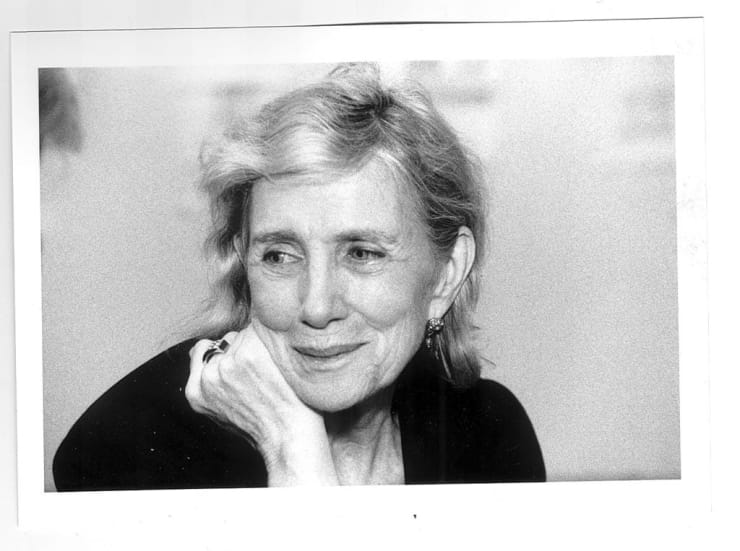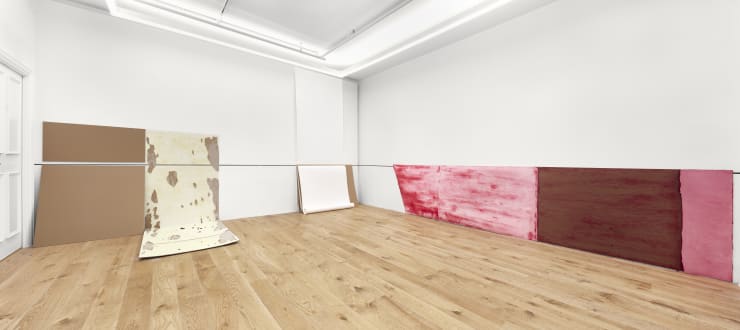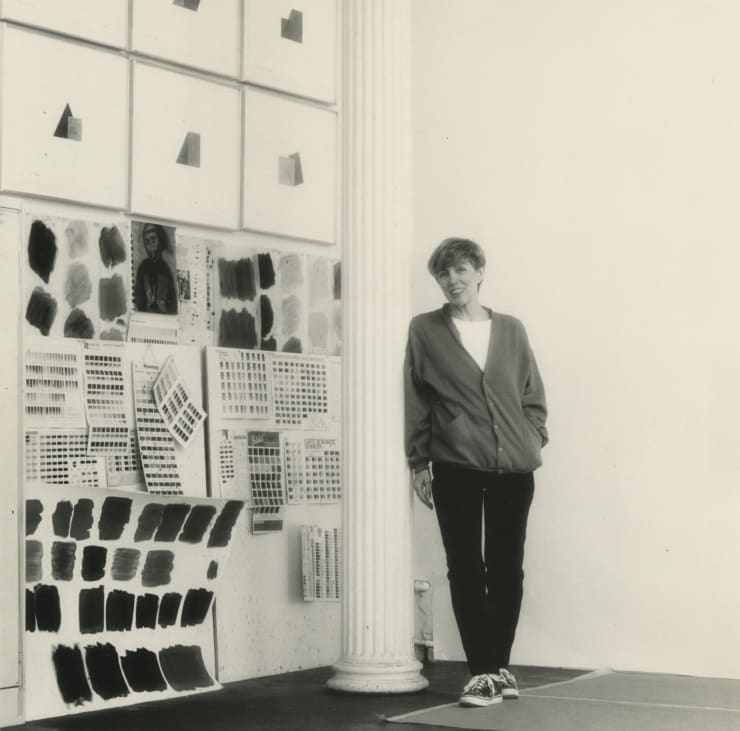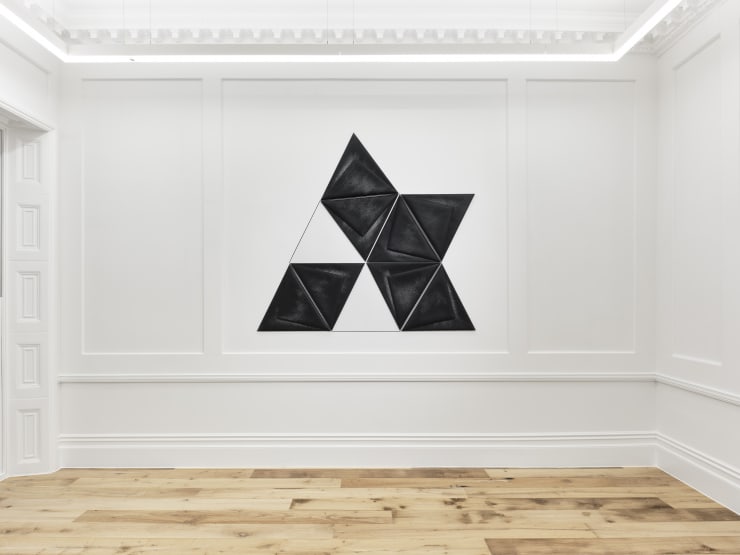The Light Shines in the Darkness and the Darkness Has Not Understood It: Dorothea Rockburne
Opening November 21, 2024 | 6 - 8 pm
Curated by Lola Kramer
Bernheim is honoured to present the first European survey exhibition of Dorothea Rockburne, curated by Lola Kramer, on view at the gallery’s London location. This historical exhibition comprises over two dozen artworks dating from 1967 to 2013, most of which will be on display in Europe for the first time. The Light Shines in the Darkness and the Darkness Has Not Understood It traces the evolution of Rockburne’s momentous and groundbreaking practice in New York from her seminal early experiments with wrinkle-finish paint to her rigorously folded works in vellum and linen to luxuriant geometric paintings exploring spatial dynamics and topology. By reconstituting many of her most iconic works and significant series in a chronological narrative, the exhibition will allow visitors to understand Rockburne’s remarkably diverse output as a multifaceted whole and the pivotal figure she has been for nearly seven decades.
The exhibition takes its title from the Latin phrase “Lux in tenebris lucet et tenebrae eam non comprehenderunt,” one which appears in John:5 and which Rockburne has referenced in various ways throughout the late 80s. Having interpreted a new translation for herself, the phrase initiates one of many dichotomies – along with “surface and light, structure and plane, nuanced color and transparency, and shadow and lustre,” all of which Rockburne has continually pulled into her expansive formal language and that engage the viewer.(1) As critic John Yau has put it, "Her interlocking, contradictory combinations of light and dark, transparency and shadow, form and bodilessness supersede the social foundations of perception with something far more elemental."(2)
By the late 1960s and early 1970s, Rockburne had repurposed her painting studies in Montréal, along with her training in mathematics and dance in the early 1950s at Black Mountain College to influence her approaches to art-making. At Black Mountain, she studied with painters associated with Abstract Expressionism, including Franz Kline and Jack Tworkov, as well as classmates Robert Rauschenberg and Cy Twombly, who later counted among the ranks of the neo–avant-garde.
Rockburne developed a procedural form of working; she manipulated unconventional materials according to mathematical logic, evoking a realm that lies beyond physical boundaries. She explored new structural possibilities for expressing discrete mathematics in physical space. From simple geometry, she turned to set theory—the study of how objects and information are organised symbolically—to arrange groups of materials and actions, making the notions of belonging—conceptually, materially, or physically—unsubtly pronounced. She applied experimental materials like crude oil, grease, and tar, creating surfaces encoded with their production methods and processes. These works feature richly textured and lush materials, which index the artist’s labor and viscerally affect the viewer.
Following the earliest work in the exhibition, Tropical Tan, 1967-68, Rockburne’s large-scale installation titled Domain of the Variable, 1972––a work in the collection of Dia, and which graced the cover of Artforum in March 1972––will expand throughout the entire ground floor to rest in its occupation of a single gallery room. The exhibition features a selection of other artworks recently presented in her 2018 Dia Beacon survey, including the Golden Section Paintings (1974-76) and the Egyptian Paintings (1979-80), among others. We are honoured to have the chance to present these groundbreaking works to a new audience, most of which have only been shown in public institutions. The layout and architecture of the gallery will allow for an intimacy between the viewer and the materials that will give new dimensions to these works.
The exhibition also follows Dorothea Rockburne, the first in-depth monograph of the artist’s seven-decade career, edited by art historian and critic Eva Diaz and published by Dia Art Foundation and Yale University Press in September 2024.
-
 Dorothea RockburneBasalt, 1981Oil, glue, pencil and gesso on canvas179.705 x 198.12 cm
Dorothea RockburneBasalt, 1981Oil, glue, pencil and gesso on canvas179.705 x 198.12 cm
70 3/4 x 78 in -
 Dorothea RockburneEgyptian Painting: Sepa, 1980Conté crayon, pencil, oil and gesso on linen
Dorothea RockburneEgyptian Painting: Sepa, 1980Conté crayon, pencil, oil and gesso on linen
236.22 x 176.53 cm
93 x 69 1/2 in -
 Dorothea RockburneEgyptian Painting, Scribe, 1979Gesso, glue, pencil and oil on linen236.2 x 143.5 cm
Dorothea RockburneEgyptian Painting, Scribe, 1979Gesso, glue, pencil and oil on linen236.2 x 143.5 cm
93 x 56 1/2 in -
 Dorothea RockburneCopal VIII, 1979Kraft paper, copal oil varnish, coloured pencil, Mylar tape, and glue on ragboard125.5 x 194.5 cm
Dorothea RockburneCopal VIII, 1979Kraft paper, copal oil varnish, coloured pencil, Mylar tape, and glue on ragboard125.5 x 194.5 cm
49 3/8 x 76 5/8 in -
 Dorothea RockburneGolden Section Painting: Rectangle/Square, 1974Gesso, glue, varnish, and coloured pencil on folded linen160 x 205.1 cm
Dorothea RockburneGolden Section Painting: Rectangle/Square, 1974Gesso, glue, varnish, and coloured pencil on folded linen160 x 205.1 cm
63 x 80 3/4 in -
 Dorothea RockburneLes Pensées de Pascal, 1987-88Oil, metal and gold leaf on linen246.0625 x 161.29 x 10.16 cm
Dorothea RockburneLes Pensées de Pascal, 1987-88Oil, metal and gold leaf on linen246.0625 x 161.29 x 10.16 cm
96 7/8 x 63 1/2 x 4 in -
 Dorothea RockburneExtasie, 1983Oil paint on linen
Dorothea RockburneExtasie, 1983Oil paint on linen
206.375 x 193.04 x 10.16 cm
81 1/4 x 76 x 4 in -
 Dorothea RockburneVellum Curve P/S 1st Version, 1978French vellum, mylar tape, varnish, colored pencil113.03 x 87.63 cm
Dorothea RockburneVellum Curve P/S 1st Version, 1978French vellum, mylar tape, varnish, colored pencil113.03 x 87.63 cm
44 1/2 x 34 1/2 in -
 Dorothea RockburneUriel , 1982-83Double-sided color lithograph on two sheets of Transpagra vellum paper, folded and mounted on ragboard108.2675 x 89.535 cm
Dorothea RockburneUriel , 1982-83Double-sided color lithograph on two sheets of Transpagra vellum paper, folded and mounted on ragboard108.2675 x 89.535 cm
42 5/8 x 35 1/4 in
-

The Mathematic Art of Dorothea Rockburne
ArtReviewElla Nixon, January 16, 2025 -

‘Somehow You Do the Impossible’: At 95, Dorothea Rockburne Reflects on Her Polymathic Career
Artnet NewsKatie White, January 9, 2025 -

Dorothea Rockburne: The Light Shines in the Darkness and the Darkness Has Not Understood It
The Brooklyn RailMark Hudson, December 17, 2024 -

Visit This: Dorothea Rockburne's Geometric Abstractions, Now on View in London
The New York Times Style MagazineLaura Bannister, November 28, 2024 -

Dorothea Rockburne – New York great’s first big UK show all comes down to one long, mesmerising line
The GuardianAdrian Searle, November 27, 2024 -

Dorothea Rockburne and Walter Robinson on Sex, Fame, and Mathematics
Interview MagazineWalter Robinson, November 26, 2024 -

At 95, Artist Dorothea Rockburne Is Still Using Math to Explore the Sublime
Grace Edquist, November 25, 2024 -

Dorothea Rockburne: The Light Shines in the Darkness and the Darkness Has Not Understood It
Air MailElena Claravino, November 25, 2024




























